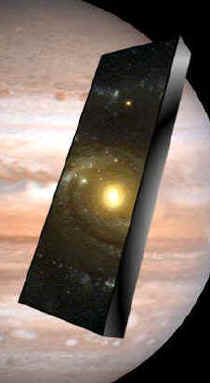
Posted on 12/14/2005 10:12:29 AM PST by SunkenCiv
Astronomers working in Canada, France and the United States said they had found a small deep-space object, nicknamed Buffy, that challenges mainstream theories about the evolution of the Solar System. The rock lies in the Kuiper Belt, the name for the flock of objects beyond Neptune's orbit that are believed to be leftover rubble from the Solar System's building phase and are the source for many comets... Measuring between 500 and 1,000 kilometers (300 to 600 miles) across and taking about 440 years to make just one circuit of the Sun, Buffy is remarkable not for its size -- around half a dozen identified Kuiper Belt objects are bigger -- but for its location and orbital tilt... Buffy has an almost perfect circular orbit and encircles the Sun at an extreme tilt, at 47 degrees to the orbital plane of the planets as they swing around the Sun... Buffy is the temporary name given by the team for the object, whose official designation by the Paris-based International Astronomical Union (IAU) is 2004 XR 190. Its orbit is in a relatively narrow range of between 52 and and 62 astronomical units (AU) from the Sun (an AU is a standard measurement, being that of the distance between the Earth and the Sun, of approximately 150 million kilometers, or 93 million miles). By comparison, another "extended scattered disk" member called Sedna swings out to as far as 900 AU before coming as close to the Sun as 76 AU.
(Excerpt) Read more at physorg.com ...
Archaeologica · Mirabilis · Texas AM Anthropology News · ArchaeoBlog
Archaeology magazine · Biblical Archaeology Society · Archaeology Odyssey · post a topic
Please FREEPMAIL me if you want on or off the
"Gods, Graves, Glyphs" PING list or GGG weekly digest
-- Archaeology/Anthropology/Ancient Cultures/Artifacts/Antiquities, etc.
Gods, Graves, Glyphs (alpha order)
ping
Well, gag me with a spoon.

Astronomers poised to apply novel way to look for comets beyond Neptune
EurekAlert | 7-Jan-2003 | Anne Stark
Posted on 11/07/2005 10:41:04 PM PST by SunkenCiv
http://www.freerepublic.com/focus/f-chat/1517866/posts
Giant Kuiper Belt planetoid Sedna may have formed far beyond Pluto
Physics Org (http://www.physorg.com/) | January 24, 2005 | Southwest Research Institute
Posted on 10/22/2005 1:05:39 PM PDT by SunkenCiv
http://www.freerepublic.com/focus/f-chat/1507383/posts
Tenth Planet Has a Moon!
Space and Earth science | October 03, 2005 | E-Mail Newsletter
Posted on 10/22/2005 9:33:39 PM PDT by vannrox
http://www.freerepublic.com/focus/f-chat/1507542/posts
I think it's the remains of a planet that broke apart, perhaps due to a collision.
I didn't know the contractor for my master suite project had been doing business back then.
One possibility, the discoverers say, is that, in the infant days of the Solar System, the nascent Neptune lay much closer to the Sun.
Hmmmm...as did the Earth when the earth year had only 10 months of 30 days. Wonder what might have bumped into it?

Nice moonlets

aimhigh: I think it's the remains of a planet that broke apart, perhaps due to a collision.Perhaps a minor planet / asteroid.
steve-b: I didn't know the contractor for my master suite project had been doing business back then.And he's still not done.
Fred Nerks: One possibility, the discoverers say, is that, in the infant days of the Solar System, the nascent Neptune lay much closer to the Sun.I thought you'd like that. :')
martin_fierro: [image of The Monolith]I guess we'd better attempt no landing there...
atomicpossum: Well, gag me with a spoon.Oddly enough, as I searched for older topics using Google, I found at least one page which claimed that FReepers hate Buffy the Vampires Layer. I don't, although I do think the show is abysmally stupid.
Buffy the Vampires Layer...LOL!
> as did the Earth when the earth year had only 10 months of 30 days. Wonder what might have bumped into it?
Nothing. What has happened is that the sun has lost considerable mass over the last 5 billion years, whereas the planets have not lost much in the way of kinetic energy or angular momentum WRT their orbits. So as the sun lost mass, the planets sloooowly drifted out. A process which will continue.
Bodies in prograde orbits enjoy a transfer of momentum from the rotation parent body, and migrate outward. However, that is a slow process. It hasn't anything to do with any loss of mass of the Sun. Also, the atmosphere of Jupiter is enriched in noble gases, and members of the team which discovered that suggested that it indicated an origin for Jupiter that lay past the outer planets today.
Hey, I steal from the best. ;') Actually, I adapted that from some sitcom joke, but forgot to put in the possessive apostrophe. :'o
>Bodies in prograde orbits enjoy a transfer of momentum from the rotation parent body, and migrate outward. However, that is a slow process. It hasn't anything to do with any loss of mass of the Sun.
True. Nevertheless, the sun has lost considerable mass, and this process has *also* led to the outwards progression of planetary orbits. There is also photon pressure and the solar winds; while trivial forces compared to the mass of the planets, nevertheless over billions of years, some effects can be seen.
This is very odd. Circular is no big deal; neither is a 47 degree inclination. It's the combination of the two that need an explanation.
Spitzer Sees the Aftermath of a Planetary Collision
Universe Today | Jan. 10, 2005 | Dolores Beasley and Gay Yee Hill
Posted on 01/13/2005 8:50:18 PM PST by SunkenCiv
http://www.freerepublic.com/focus/f-chat/1320521/posts
Red Planet's Ancient Equator Located
Scientific American (online) | April 20, 2005 | Sarah Graham
Posted on 04/24/2005 8:18:25 PM PDT by SunkenCiv
http://www.freerepublic.com/focus/f-chat/1390424/posts
Disclaimer: Opinions posted on Free Republic are those of the individual posters and do not necessarily represent the opinion of Free Republic or its management. All materials posted herein are protected by copyright law and the exemption for fair use of copyrighted works.